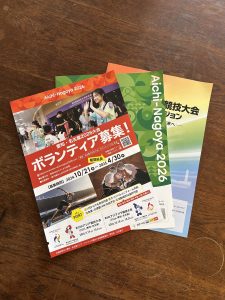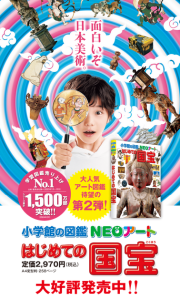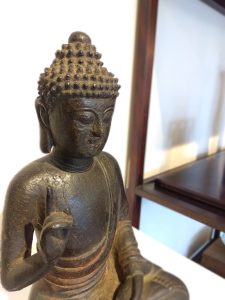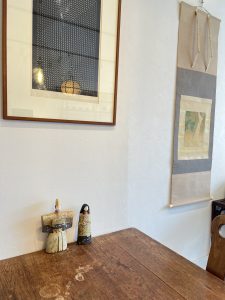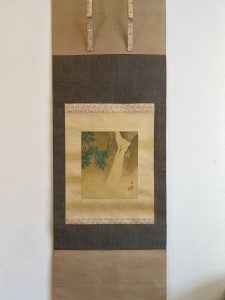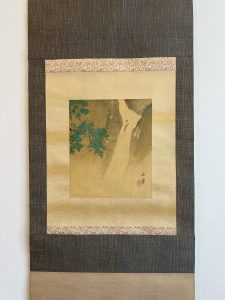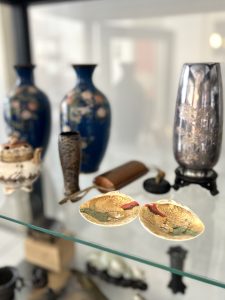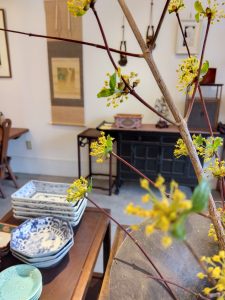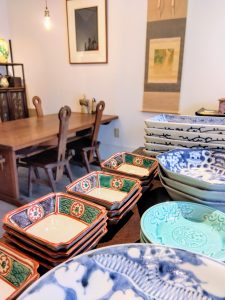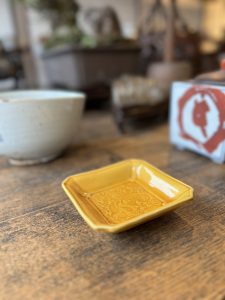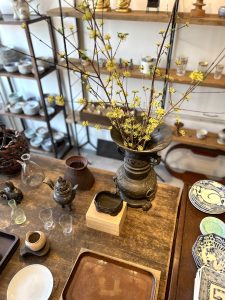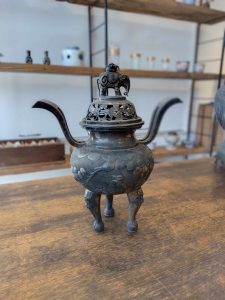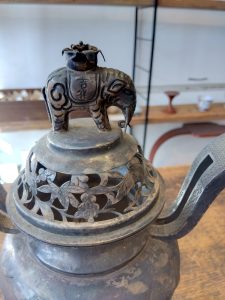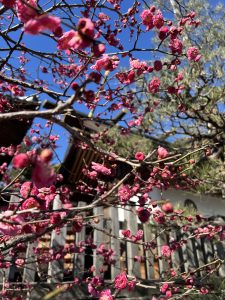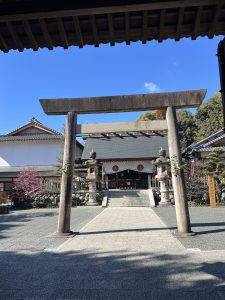梅派?桜派?、質問の回答がいつも面白いです。(愛知県名古屋市千種区姫池通 骨董買取 古美術風光舎)
2025.03.06
先ほど車で通りかかった公園でもう満開の桜?を発見しました。一瞬目を疑う光景でしたが、先日から河津桜のニュースも流れていたりと早咲きの桜がすでに満開であってもおかしくない時期ではありますね。そんな風景を横目に住宅街を通り抜けていますと、今度は庭先にしっとりと咲きはじめた梅を咲かせたお宅もたくさん見かけまして。どちらの花もこの寒さに耐え、ようやっと咲いたかと思うと「よく頑張った…」なんてしみじみ思うわけですよ…。
このところ続いた雨あがりのそらに桜も梅もとてもきれいに咲いていますね。
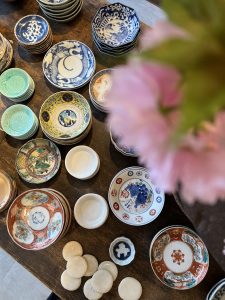
ところで、突然ではありますが、皆さまは梅派?桜派?どちらでしょうか。
たわいもない質問なのですがこの質問を投げかけると、その選んだ理由が皆さんいろいろなんですよ。
スタッフYが尋ねた周りの人の回答例としては、「梅かな、梅干し好きだし」「桜かな、なんだか時期的にワクワクする」「梅。あの香りが好き」「桜餅食べたい」「佐藤錦って高いよね」「桜の花見ってなんであんなに大イベントなんだ?」「梅の花見ってしないよね、さむいからか?」「桜感動するよね、写真も映えるし」などと、この質問はいろいろなネタに派生しやすいようで、いつもたいへん面白いですね。
個人的には今のところは「梅」派でありまして。先ほども、とあるお宅の庭先にしだれ梅が見事に咲いており、しばし足を止めて怪しい人にならないように眺めておりました。まだ枯れた草木の中に咲くその姿が「孤高の存在」、それでいて近づくと上品な香りが高貴でいてさらに近づけない存在のように思え、こと固く花をつけたしだれ梅が大好きで、本日眺めていたしだれ梅もその周りだけがよそとは違う佇まいでありました。
また、あの苔むした幹は、国宝「紅白梅図屏風」もお分かりのように、あの尾形光琳でさえも魅了されたのですから、誰しもが目を奪うところなのでありましょう。
また、父親や大人たちが梅の剪定をしていたり話したりしていて、子どもながら「大人しか扱えないのだな…」なんて思っていたのですが、すっかり大人になった今でも永遠の大人のあこがれのままであります。
この寒さの中、ふと足を止めしだれ梅を眺め、完全に「梅派」を主調していたわけですが、来月の今頃「やっぱ桜だわ」なんて呟いているかもしれませんが、それはそれでお許しください。前述のとおり「今のところは梅派」です笑。
それではごきげんよう。(スタッフY)
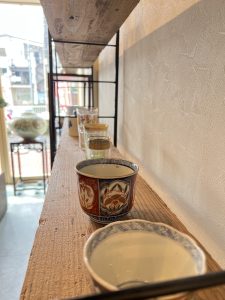
I just drove by a park and found cherry blossoms already in full bloom? I couldn’t believe my eyes for a moment. It was a sight that made me doubt my eyes for a moment, but news of Kawazu cherry blossoms had been broadcast the other day, so it is not surprising that the early-blooming cherry trees are already in full bloom. Passing through a residential area with such a scene by my side, I saw many houses with plum blossoms that were beginning to bloom quietly in their yards. Both of these flowers have endured the cold and finally bloomed, and I think to myself, “They did their best….
The cherry and plum blossoms are both blooming beautifully in the clear sky after the rain that has been continuing recently.
By the way, not because it is this time of the year, but because I am wondering if you are a plum tree person or a cherry tree person? Or are you a cherry blossom person? Which do you prefer?
It is a trivial question, but when I asked this question, everyone had various reasons for their choice.
Some of the responses from those around us that Staff Y asked were: “Plum, I like pickled plums,” “Sakura, it’s an exciting time of year,” “Plum, I like the aroma,” “Sakura-mochi, I like the smell,” “Sakura, I like sakura-mochi. I like its aroma,” ‘I want to eat sakura mochi (rice cake with sakura blossoms),’ ‘Sato Nishiki is expensive,’ ”Why is cherry blossom viewing such a big event? “I don’t think people go to see ume blossoms, is it because it’s too cold?” It is always very interesting to see how these questions can be easily derived into a variety of topics.
Personally, I am in the “plum” camp at the moment. A few days ago, I saw a beautiful weeping plum tree blooming in the garden of a house, and I stopped for a moment to look at it without becoming a suspicious person. I love weeping Japanese apricots with their flowers on, and the weeping Japanese apricot I was admiring today had a different appearance from the others around it.
The mossy trunks of the weeping plum trees, as you can see in the National Treasure “Red and White Plum Blossoms,” attracted even Korin Ogata, so they must be a sight to behold for anyone.
I also saw my father and other adults pruning and talking about ume trees, and even as a child I thought to myself, “Only adults can handle this…” Even now that I am all grown up, it remains an eternal longing for me as an adult.
In this cold weather, I suddenly stopped to look at weeping plum trees and was completely in the “plum faction,” but please forgive me if this time next month I am muttering, “I knew it was the cherry blossoms. As I mentioned before, I am a “ume-people” at the moment, lol.
Have a good day.
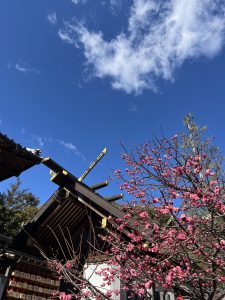
*****************
ご実家の整理やお片付けなどをされている方のご相談などが多くございます。
お片付けなどくれぐれもご無理のないようになさってくださいませ。
風光舎では古美術品や骨董品の他にも絵画や宝石、趣味のお品など様々なジャンルのものを買受しております。
お片付けをされていて、こういうものでもいいのかしらと迷われているものでも、どうぞお気軽にご相談下さいませ。
また風光舎は、出張買取も強化しております。ご近所はもちろん、愛知県内、岐阜県、三重県その他の県へも出張いたします。
まずは、お電話お待ちしております。
愛知県名古屋市千種区姫池通
骨董 買取【古美術 風光舎 名古屋店】
TEL052(734)8444
10:00-18:00 OPEN
#出張買取#骨董#古美術#骨董品#絵画#版画#茶道具#刀剣#彫刻


